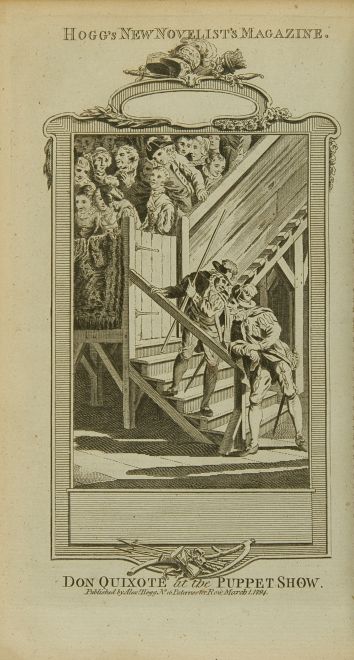
click to enlarge
Maybe, it has been re-used from a different novel.
The ornamental frame includes Mars' arms (helmet, sword and arrows), Cupid's arms (arrows) and symbols of Time or Death (sand clock and scythe); good decorative effect.
Good drawing.
The plate is not signed either by the illustrator or by the engraver, but Río y Rico attributes it to Riley and Scott, who sign the frontispiece.
It is dated on March 1, 1794.
"... en vano buscaréis en esta imagen al propio Don Quijote, o a Sancho Panza, o al ventero, o a maese Pedro. Lo que se ve ahí es un público londinense, como los que a fines de aquel siglo acudían a admirar al gran actor Garrick, en sus creaciones shakespearianas, o se apretujaban hasta lo inverosímil para ver la Beggar's Opera, el melodrama de bandidaje, sentimental y musical, que en Francia llamaron luego l'Opéra de Quatre Sous («La Ópera de Cuatro Cuartos»), en nuestros días resucitada y popularizada por el cine norteamericano. Los espectadores, vestidos como en 1794, llenan el «gallinero», cerrado con puerta y valla. Dos guardianes cuchichean al pie del entarimado. [...] Esta edición inglesa, con las tres muestras que de sus contradictorias estampas acabamos de ver, nos sitúa en la pleamar de la enorme marejada que conduce las aguas del siglo XVIII, llenas de restos y escorias de un mundo abatido, a desembocar en las dilatadas márgenes del XIX, uno de los más originales de la historia humana y de la quijotesca" (Givanel 178-179).